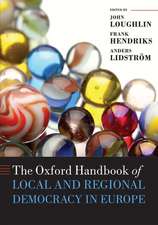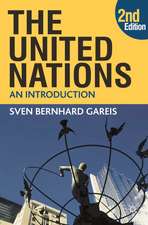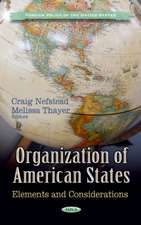An Introduction to European Intergovernmental Organizations
Autor Marc Cogenen Limba Engleză Hardback – 28 ian 2015
Preț: 629.82 lei
Preț vechi: 841.83 lei
-25% Nou
Puncte Express: 945
Preț estimativ în valută:
120.52€ • 126.15$ • 100.31£
120.52€ • 126.15$ • 100.31£
Carte tipărită la comandă
Livrare economică 31 martie-14 aprilie
Preluare comenzi: 021 569.72.76
Specificații
ISBN-13: 9781472445704
ISBN-10: 1472445708
Pagini: 300
Dimensiuni: 174 x 246 x 24 mm
Greutate: 0.72 kg
Ediția:New ed
Editura: Taylor & Francis
Colecția Routledge
Locul publicării:Oxford, United Kingdom
ISBN-10: 1472445708
Pagini: 300
Dimensiuni: 174 x 246 x 24 mm
Greutate: 0.72 kg
Ediția:New ed
Editura: Taylor & Francis
Colecția Routledge
Locul publicării:Oxford, United Kingdom
Notă biografică
Marc Cogen teaches currently international and European law at Vesalius College in Brussels. He has published on general international law and key issues of European cooperation. He was a consultant and advisor of several governments.
Cuprins
Introduction; Part I Economic and Financial Sectors; Chapter 1 The Benelux Union; Chapter 2 The European Free Trade Association (EFTA); Chapter 3 European Organization for the Safety of Air Navigation (Eurocontrol); Chapter 4 European Patent Organization (EPO); Chapter 5 European Bank for Reconstruction and Development (EBRD); Chapter 6 Nordic Investment Bank (NIB); Chapter 7 Nordic Environment Finance Corporation (NEFCO); Chapter 8 Nordic Development Fund (NDF); Chapter 9 Black Sea Trade and Development Bank (BSTDB); Chapter 10 Organization of the Black Sea Economic Cooperation (BSEC); Chapter 11 Council of Europe Development Bank (CEB); Chapter 12 The Energy Charter Conference (ECC); Chapter 13 Energy Community (EC); Part II Political and Security Sectors; Chapter 14 Council of Europe; Chapter 15 Organization for Security and Cooperation in Europe (OSCE); Chapter 16 North Atlantic Treaty Organization (NATO); Chapter 17 Nordic Cooperation; Chapter 18 Baltic Cooperation; Part III Science; Chapter 19 European Organization for Nuclear Research (CERN); Chapter 20 European Organization for the Exploitation of Meteorological Satellites (EUMETSAT); Chapter 21 The European Southern Observatory (ESO); Chapter 22 European Space Agency (ESA); Part IV River Commissions and Environmental Organizations; Chapter 23 Central Commission for the Navigation of the Rhine (CCNR); Chapter 24 Danube Commission (DC); Chapter 25 International Sava River Basin Commission (ISRBC); Chapter 26 Commission on the Protection of the Black Sea against Pollution (BSC); Chapter 27 International Commission for the Protection of the Danube River (ICPDR); Chapter 28 European and Mediterranean Plant Protection Organization (EPPO);
Descriere
An Introduction to European Intergovernmental Organizations provides an up-to-date and accessible reference to European intergovernmental organizations other than the European Union. The specialized character of these organizations adds value to cooperation in Europe as a whole, creates permanent channels of communication regardless of EU membership and allows the possibility for non-European involvement through organizations such as the European Bank for Reconstruction and Development and NATO. It also allows sub regional groups of states, such as the Nordic countries or the Benelux countries to exist and express their own identity via their own organizations.












